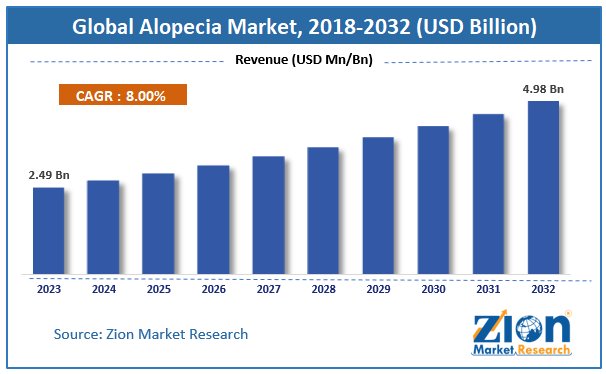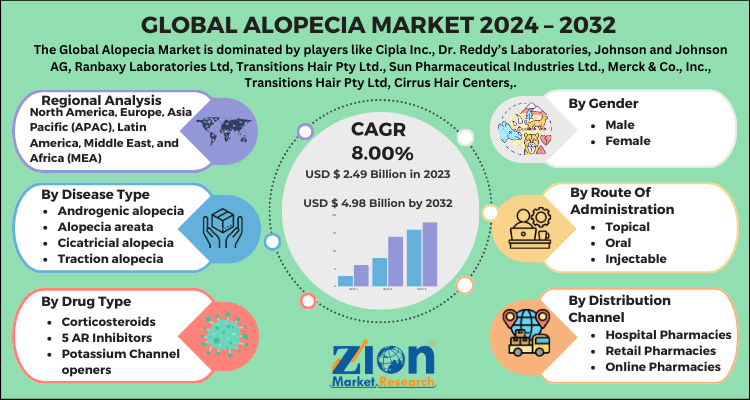Alopecia Market Size, Share, Trends, Growth Report 2032

Alopecia Market By Disease (Androgenic Alopecia, Alopecia Areata, Cicatricial Alopecia, Traction Alopecia, Alopecia Totalis, Alopecia Universalis, And Others, By Drug Type (Corticosteroids, 5 Ar Inhibitors And Others), By Gender (Male, Female); By Route Of Administration (Topical, Injectable And Oral) And Distribution Channel (Retail Pharmacies, Hospital Pharmacies And Online Pharmacies), And By Region - Global And Regional Industry Overview, Market Intelligence, Comprehensive Analysis, Historical Data, And Forecasts 2024-2032
| Market Size in 2023 | Market Forecast in 2032 | CAGR (in %) | Base Year |
|---|---|---|---|
| USD 2.49 Billion | USD 4.98 Billion | 8.00% | 2023 |
Alopecia Market: Size
The Global Alopecia Market size was worth around USD 2.49 Billion in 2023 and is estimated to grow to about USD 4.98 Billion by 2032, with a compound annual growth rate (CAGR) of approximately 8.00% over the forecast period.
The report analyzes the Alopecia market’s drivers, restraints/challenges, and the effect they have on the demands during the projection period. In addition, the report explores emerging opportunities in the Alopecia market.
The report covers forecasts and analyses for the Alopecia market on a global and regional level. The study provides historic data from 2018 to 2022 along with a forecast from 2024 to 2032 based on revenue (USD Billion). The study includes drivers and restraints for the Alopecia market along with the impact they have on the demand over the forecast period. Additionally, the report includes the study of opportunities available in the Alopecia market on a global level.
Alopecia Market: Overview
Alopecia can be classified into several types, including androgenetic alopecia (male and female pattern baldness), alopecia areata (an autoimmune disorder causing patchy hair loss), and other forms like traction alopecia and telogen effluvium. Treatments range from topical and oral medications to advanced therapies like platelet-rich plasma (PRP) and hair transplant surgeries. Alopecia, a condition characterized by hair loss, affects millions of people worldwide, impacting their self-esteem and quality of life. The market for alopecia treatments is expanding rapidly due to increasing awareness, rising prevalence, and advancements in treatment options.
The word alopecia means hair loss. Alopecia isn't limited to the scalp; it's possible on the body anywhere. The hair cycle comprises three phases: Anagen, which is called the growth phase. The second phase is catagen, also called as rest phase, and the fading phase is called as telogen phase. Ninety percent of the hair is in the development period (anagen) and the remainder, which corresponds to ten percent in the resting and shedding phases. When the hair falls out, this is the telogen phase and the hair is going to regenerate, and it begins to develop again in the (development) anagen process. Alopecia can be subdivided into two broad categories: scarring and non-scarring.
Non-scarring or androgenic alopecia is the most common form. Many men start losing hair in their 20s, while women start losing their hair in their 40s or 50s. As a person grows older they lose hair. The pattern is the disparity between masculine hair loss and female hair loss. The front and temporal zone is the area where men usually lose hair because this area is more sensitive to di-hydrogen testosterone. while women appear to lose hair from the scalp's central field. Female hair loss will also not result in complete baldness, while male hair loss can result in complete baldness. Males do not lose hair in the back of the scalp as this area is androgenic hormone-resistant.
In order to give the users of this report a comprehensive view of the Alopecia market we have included a competitive landscape and analysis of Porter’s Five Forces model for the market. The study encompasses a market attractiveness analysis, wherein the disease, drug type, gender, route of administration, distribution channel, and regional segments are benchmarked based on their market size, growth rate, and general attractiveness.
Alopecia Market: Growth Drivers
The increase in lifestyle spending as well as growing people's awareness drives the growth of the market for alopecia treatment. In addition, the rise in the occurrence of chronic diseases, like acute stress disorder, polycystic ovary disease (PCOD), hyperthyroidism, hypothyroidism, cancer, lupus, and hypopituitarism is accelerating the growth of the demand for alopecia treatment. An increasingly aging population and an increasing number of people concerned with improving their hair are expected to boost the market for alopecia treatment.
The increasing demand for surgical hair transplants and increased customer awareness of possible treatments, like prp treatment in turn boosts the growth of the market for alopecia treatment. However, the high cost and adverse effects associated with treatment may hamper the growth of the market for alopecia treatment.
Alopecia Market: Segmentation
The study provides a decisive view of the alopecia market by segmenting the market based on disease, drug type, gender, route of administration, distribution channel, and regions. All the segments have been analyzed based on present and future trends and the market is estimated from 2024 to 2032.
Based on disease, the market is segmented into androgenic alopecia, alopecia areata, cicatricial alopecia, traction alopecia, and others. The study projects that the alopecia areata will dominate the Alopecia market owing to the upsurge in the number of patients suffering from the alopecia areata.
Based on drug type, the market is segmented into corticosteroids, 5 are inhibitors, potassium channel openers, and others. The corticosteroids segment is expected to dominate the market due to the more number of patients being treated by Corticosteroids in the treatment of alopecia areata.
Based on gender, the market is segmented into male and female .
Based on distribution channels, the market is segmented into Retail Pharmacies, Hospital Pharmacies, and Online Pharmacies.
Alopecia Market: Report Scope
| Report Attributes | Report Details |
|---|---|
| Report Name | Alopecia Market Research Report |
| Market Size in 2023 | USD 2.49 Billion |
| Market Forecast in 2032 | USD 4.98 Billion |
| Growth Rate | CAGR of 8.00% |
| Number of Pages | 130 |
| Forecast Units | Value (USD Billion), and Volume (Units) |
| Key Companies Covered | Cipla Inc., Dr. Reddy’s Laboratories, Johnson and Johnson AG, Ranbaxy Laboratories Ltd, Transitions Hair Pty Ltd., Sun Pharmaceutical Industries Ltd., Merck & Co., Inc., Transitions Hair Pty Ltd, Cirrus Hair Centers, Lexington International LLC, Vita-Cos-Med Klett-Loch GmbH, Follica, Inc., and Capillus. among others among others. |
| Segments Covered | By Disease Type, By Drug Type, By Gender, By Route of Administration, By Distribution Channel, And By Region |
| Regions Covered | North America, Europe, Asia Pacific (APAC), Latin America, Middle East and Africa (MEA) |
| Base Year | 2023 |
| Historical Year | 2018 to 2022 |
| Forecast Year | 2024 - 2032 |
| Customization Scope | Avail customized purchase options to meet your exact research needs. Request For Customization |
Alopecia Market: Regional Analysis
The regional segmentation includes the current and forecast demand for North America, Europe, Asia Pacific, Latin America, and Middle East & Africa. Geographically speaking, North America dominated the alopecia market. The large alopecia patient pool, availability of developed infrastructure, growing awareness, and presence of key players have led to increased demand for alopecia treatment.
Alopecia Market: Competitive Players
Key players within the global Alopecia market include
- Cipla Inc.
- Dr. Reddy’s Laboratories
- Johnson and Johnson AG
- Ranbaxy Laboratories Ltd
- Transitions Hair Pty Ltd.
- Sun Pharmaceutical Industries Ltd.
- Merck & Co.Inc.
- Transitions Hair Pty Ltd
- Cirrus Hair Centers
- Lexington International LLC
- Vita-Cos-Med Klett-Loch GmbH
- Follica.Inc.
- Capillus.
- among others.
The report segments the global Alopecia market as follows:
Global Alopecia Market: Disease Segment Analysis
- Androgenic alopecia
- Alopecia areata
- Cicatricial alopecia
- Traction alopecia
- Alopecia Totalis
- Alopecia Universalis
- Others
Global Alopecia Market: Drug Type Segment Analysis
- Corticosteroids
- 5 AR Inhibitors
- Potassium Channel openers
- Others
Global Alopecia Market: By Gender Segment Analysis
- Male
- Female
Global Alopecia Market: By Route of Administration Segment Analysis
- Topical
- Oral
- Injectable
Global Alopecia Market: Distribution Channel Segment Analysis
- Hospital Pharmacies
- Retail Pharmacies
- Online Pharmacies
Global Alopecia Market: Regional Segment Analysis
- North America
- The U.S.
- Canada
- Europe
- France
- The UK
- Spain
- Germany
- Italy
- Rest of Europe
- Asia Pacific
- China
- Japan
- India
- South Korea
- Southeast Asia
- Rest of Asia Pacific
- Latin America
- Brazil
- Mexico
- Rest of Latin America
- Middle East & Africa
- GCC
- South Africa
- Rest of Middle East & Africa
Table Of Content
Methodology
FrequentlyAsked Questions
Alopecia is a medical word that refers to hair loss or baldness, which can occur on many regions of the body, but most usually affects the scalp.
The global demand for alopecia market is driven by fluctuating lifestyles leading to increasing levels of stress among the working class, increased geriatric population, high demand for surgical hair transplants and increased customer awareness of possible treatment like prp treatment are expected to drive the growth of the alopecia industry.
The Global Alopecia Market was valued USD 2.49 Billion in 2023 and is expected to rise to USD 4.98 Billion by 2032, with a CAGR of 8.00%.
North America held largest revenue share of the global Alopecia market in 2023. This large share is attributed to large alopecia patient pool, availability of developed infrastructure, growing awareness and presence of key players in this region.
Major players in Alopecia market are Cipla Inc., Dr. Reddy’s Laboratories, Johnson and Johnson AG, Ranbaxy Laboratories Ltd, Transitions Hair Pty Ltd., Sun Pharmaceutical Industries Ltd., Merck & Co., Inc., Transitions Hair Pty Ltd, Cirrus Hair Centers, Lexington International LLC, Vita-Cos-Med Klett-Loch GmbH, Follica, Inc., and Capillus. among others.
RelatedNews
HappyClients
Zion Market Research
Tel: +1 (302) 444-0166
USA/Canada Toll Free No.+1 (855) 465-4651
3rd Floor,
Mrunal Paradise, Opp Maharaja Hotel,
Pimple Gurav, Pune 411061,
Maharashtra, India
Phone No +91 7768 006 007, +91 7768 006 008
US OFFICE NO +1 (302) 444-0166
US/CAN TOLL FREE +1 (855) 465-4651
Email: sales@zionmarketresearch.com
We have secured system to process your transaction.
Our support available to help you 24 hours a day, five days a week.
Monday - Friday: 9AM - 6PM
Saturday - Sunday: Closed







